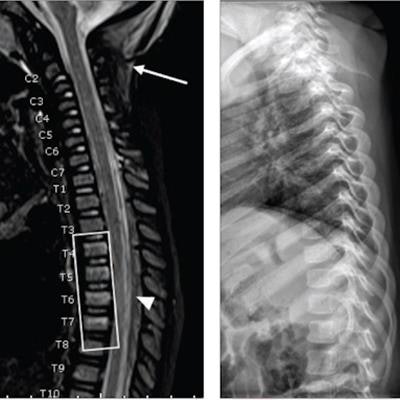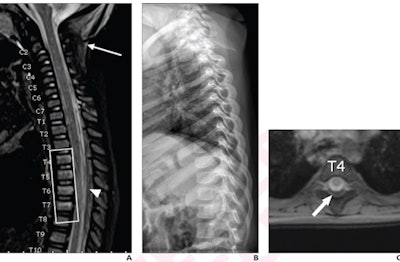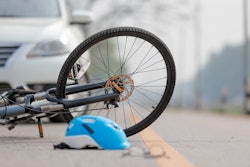
Performing MRI of the whole spine in young children thought to be victims of abusive head trauma can help detect injuries that may be missed on regular imaging, according to a study published January 12 in the American Journal of Roentgenology.
Indiana University researchers analyzed imaging data on injuries in children seen at Riley Children's Hospital in Indianapolis with suspected abusive head trauma. They found whole-spine MRI procedures showed additional abnormalities not identified on cervical spine MRI exams.
"When performing spine MRI in children with suspected [abusive head trauma], whole-spine MRI rather than cervical spine MRI may be warranted, to avoid missing isolated thoracolumbar injuries," wrote first author Dr. Boaz Karmazyn, a professor of radiology and imaging sciences.
Abusive head trauma is the most common cause of traumatic death in children under 4 years old. A thorough medical and imaging evaluation is crucial in children with suspected abusive head trauma, and evidence supports the use of cervical spine MRI. However, little such evidence exists for the utility of whole-spine MRI, and practice guidelines vary, according to the authors.
In this retrospective study, Karmazyn and colleagues aimed to evaluate whether whole-spine MRI in children suspected of abusive head trauma shows additional injuries not identified on cervical spine MRI.
The researchers included 256 children (170 boys, 86 girls) younger than 3 years old with suspected child abuse. The children underwent skeletal surveys and head MRI exams between January 2019 and December 2020 at Riley Children's Hospital, a tertiary medical center that evaluates a high volume of children suspected of child abuse. One hundred and forty-eight children underwent whole-spine MRI.
Diagnoses for abusive head trauma were established by review of clinical records, as well as injuries described in the skeletal survey, head MRI, and head CT (if performed) reports. Whole-spine MRI examinations were reviewed independently by two pediatric neuroradiologists with seven and three years of experience.
 A 16-month-old boy, born at gestational age of 28 weeks, who presented with unexplained facial burns. He also had unexplained rib, humerus, and tibial fractures, three skull fractures, severe acute hypoxic brain injury with transtentorial herniation, and intracranial subdural hematoma in the interhemispheric falx and the tentorium. The child was diagnosed with abusive head trauma. (A) Sagittal STIR image from whole-spine MRI demonstrates edema in the nuchal ligament consistent with ligamentous injury (arrow) and epidural hematoma extending along the thoracic spine (arrowhead), associated with compression fractures from T4 to T7 (rectangle). Epidural hematoma is isolated to thoracolumbar spine. (B) Lateral radiograph of the thoracic spine was clinically interpreted as negative for spine fracture. (C) Axial gradient-recalled echo T2-weighted MR image at L4 demonstrates posterior hematoma obliterating the epidural fat, consistent with epidural hematoma (arrow). Image courtesy of the American Journal of Roentgenology.
A 16-month-old boy, born at gestational age of 28 weeks, who presented with unexplained facial burns. He also had unexplained rib, humerus, and tibial fractures, three skull fractures, severe acute hypoxic brain injury with transtentorial herniation, and intracranial subdural hematoma in the interhemispheric falx and the tentorium. The child was diagnosed with abusive head trauma. (A) Sagittal STIR image from whole-spine MRI demonstrates edema in the nuchal ligament consistent with ligamentous injury (arrow) and epidural hematoma extending along the thoracic spine (arrowhead), associated with compression fractures from T4 to T7 (rectangle). Epidural hematoma is isolated to thoracolumbar spine. (B) Lateral radiograph of the thoracic spine was clinically interpreted as negative for spine fracture. (C) Axial gradient-recalled echo T2-weighted MR image at L4 demonstrates posterior hematoma obliterating the epidural fat, consistent with epidural hematoma (arrow). Image courtesy of the American Journal of Roentgenology.Results showed abusive head trauma was diagnosed in 79 out of 148 (53.4%) children who underwent whole-spine MRI, versus 2 out of 108 (1.9%) who did not undergo whole-spine MRI (p < 0.001). In children who underwent whole-spine MRI, all injuries were observed in the thoracolumbar spine, the authors found.
In addition, major findings (subdural hematoma, epidural hematoma, ligamentous injury, and spine fracture not identified by skeletal survey) were detected in 31.8% of whole-spine MRI examinations. In 51.1% of children with major findings, the major findings were limited to the thoracolumbar spine.
"While practice guidelines have recognized the role of cervical spine MRI in children with suspected [abusive head trauma], our findings indicate a role for whole-spine MRI, rather than cervical spine MRI, in this setting," the authors wrote.
"This study represents the largest reported series to our knowledge of children with suspected abusive head trauma who were evaluated by whole-spine MRI," the researchers added.
In an accompanying editorial comment, Dr. Nadja Kadom, director of pediatric neuroradiology at Emory University in Atlanta, wrote that while whole-spine imaging has utility in patients undergoing MRI for suspected abusive head trauma, further discussion is warranted.
The whole-spine protocol suggested by the authors (seven MRI series for each patient who undergoes MRI for suspected abusive head trauma) would add 16 to 19 minutes of acquisition time to the MRI examination, which may substantially affect the MRI schedule and increase the need for sedation, Kadom noted.
Moreover, there is no scientific evidence that this added information would change the outcome of medicolegal proceedings, she wrote.
At Children's Healthcare of Atlanta, Kadom's hospital, the cervical-spine sequence in the MRI protocol for abusive head trauma has been expanded to a single large field-of-view sagittal T2-weighted fat-saturated whole-spine sequence to screen for spinal injuries, she wrote.
"A comprehensive whole-spine MRI protocol is reserved for use in patients with specific clinical concerns for spinal injury," Kadom concluded.



.fFmgij6Hin.png?auto=compress%2Cformat&fit=crop&h=100&q=70&w=100)





.fFmgij6Hin.png?auto=compress%2Cformat&fit=crop&h=167&q=70&w=250)











